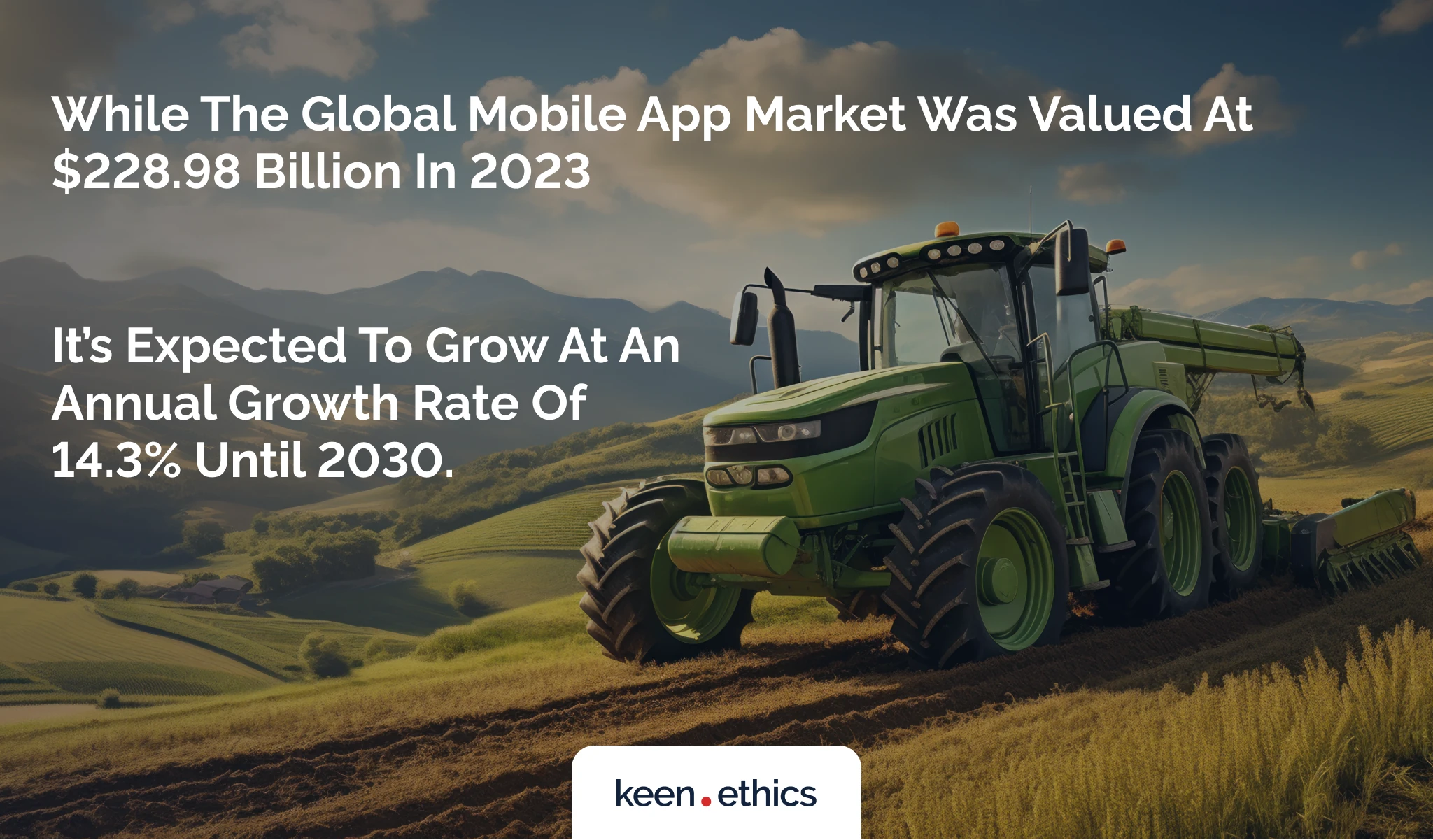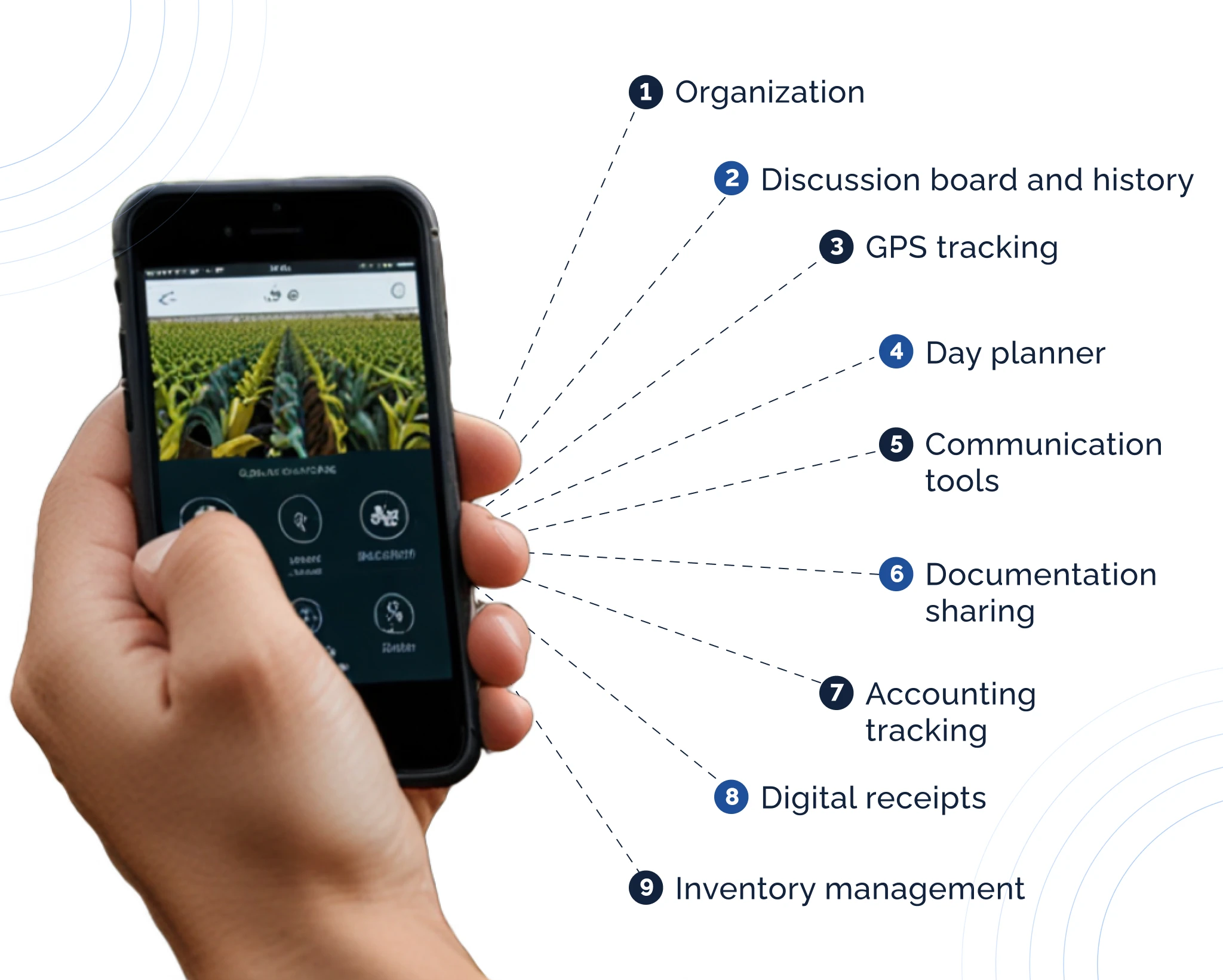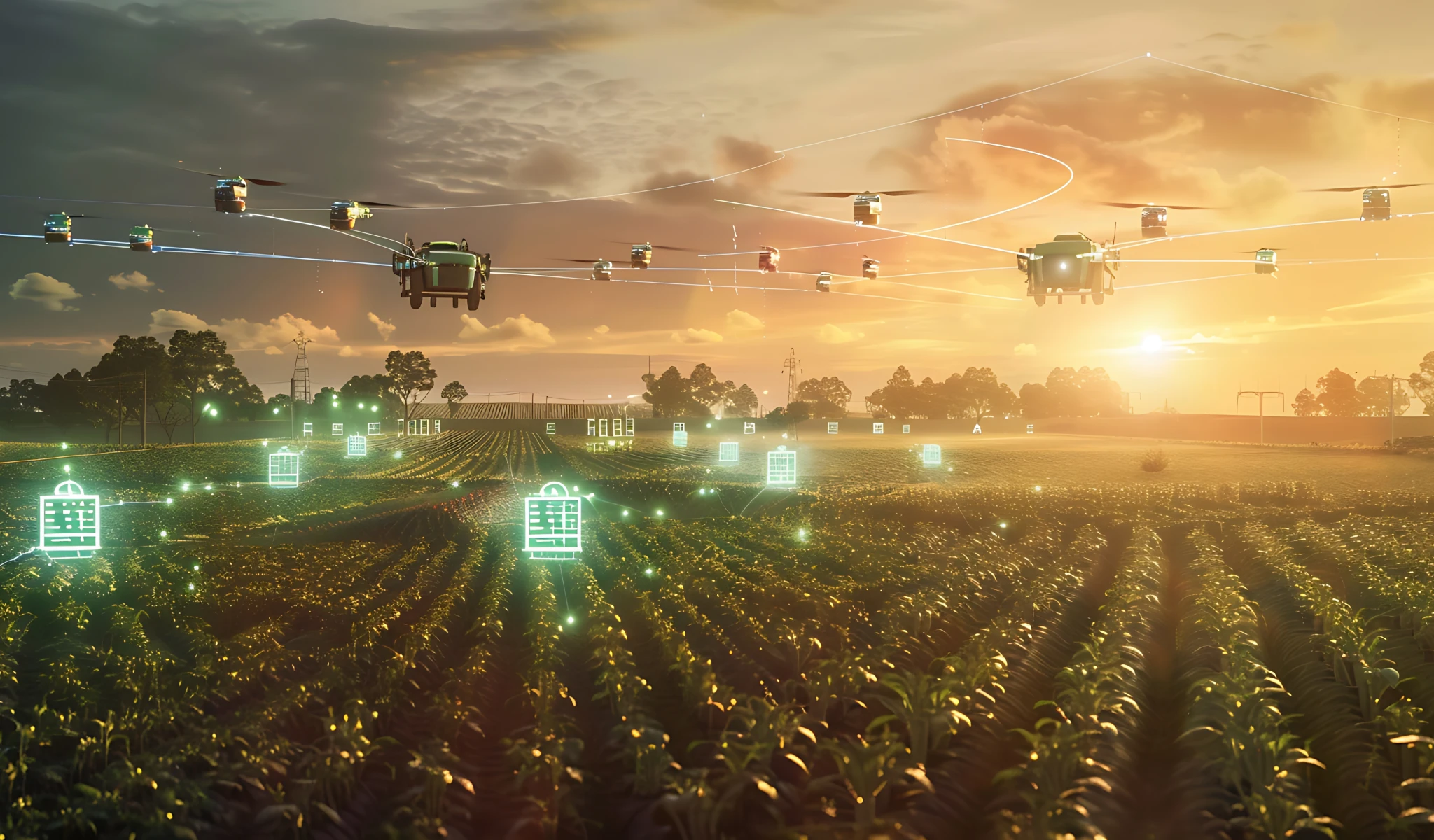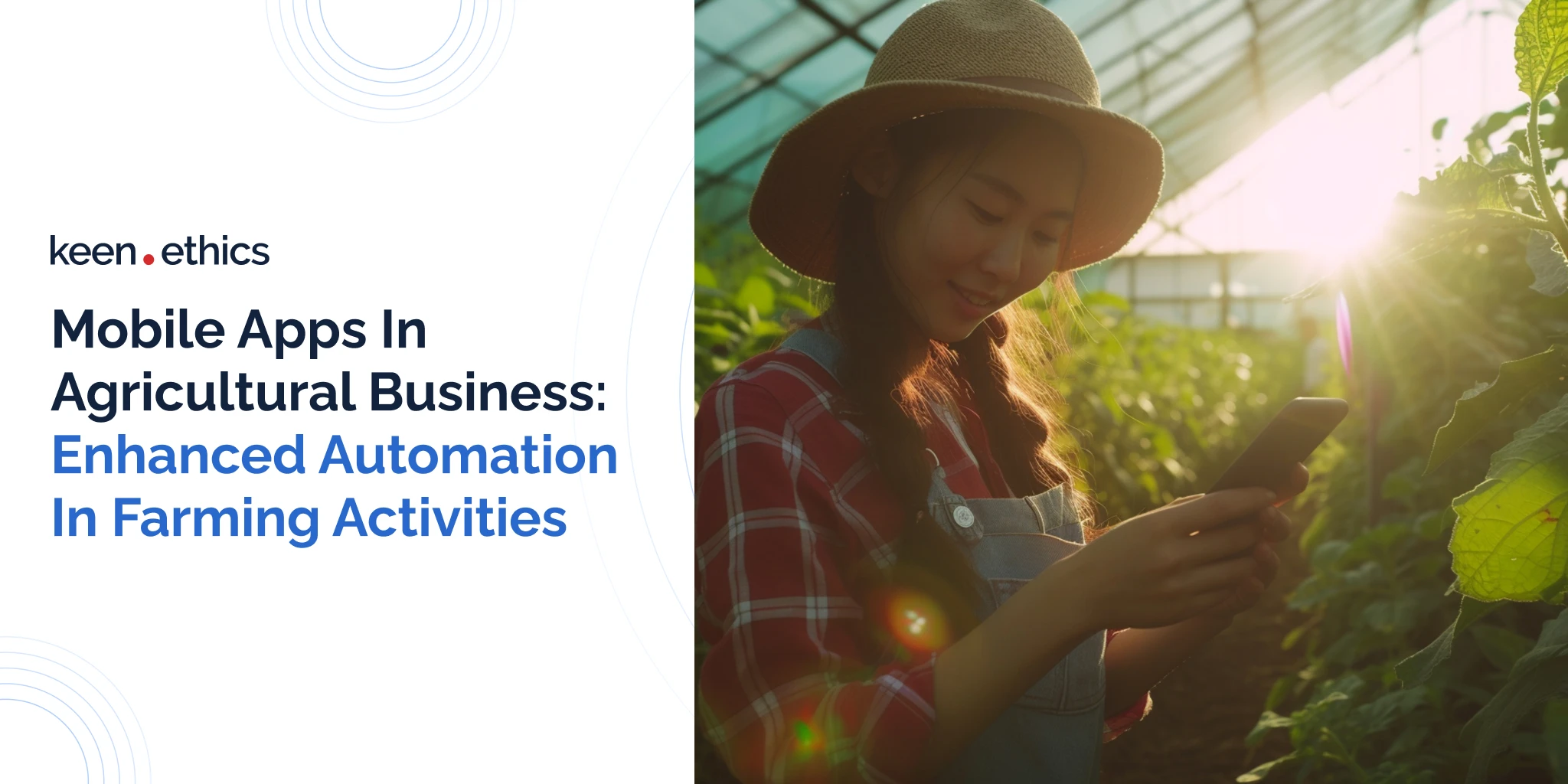The modern agricultural market is dynamic and becomes inseparable through the intersection of technology and smart farming. Modern farmers use mobile technology in agriculture to optimize processes and simplify crop and supply chain management so they spend less time on manual operations and mathematical resource allocation. In this article, we’ll explore the impact of mobile apps for agriculture, show the main pain points in developing this solution, and present you with Keenethics’ expertise in agriculture software development services. Stay with us, and learn how to make more profits in the agricultural business.
The Growth of Mobile Technology in the Agricultural Sector
The demand for mobile apps in agriculture is accelerating. The statistics show that while the global mobile app market was valued at $228.98 billion in 2023, it’s expected to grow at an annual growth rate of 14.3% until 2030.

Diverse factors influence the demand for mobile app growth. First, there is the rising usage of smartphones. Second, there is a growing demand for internet access in many sectors. Third, the wide growth of technologies like AI and machine learning makes business owners consider mobile app development.
Mobile app development in the agricultural industry is not just a trend but a practical necessity. Farmers need real-time information regarding weather, soil quality, and crop health to make the right decisions based on their farms’ current conditions. Mobile app development transforms the agricultural business into more sustainable farming practices, making it data-driven and focused on the needs highlighted by analytics.
The Role of Mobile Apps in Smart Agriculture
Mobile apps in agriculture speed up operations. With the rise of modern technology, farmers have become more accustomed to the accessibility and profits they provide. Mobile app functionality allows farmers to adapt to the customer’s demand and boost production profitability. The critical issues apps solve vary from land management to overall crop quality monitoring.
Supply chain and logistics management
Farmers can track the movement of their products from land to market. This simplifies how they manage inventory, schedule transportation, track shipments, and adhere to safety regulations. As a result, when using mobile applications in agriculture, the farmers have reduced delays, minimum losses, and improved supply chain infrastructure.
Livestock management apps
The mobile apps for agriculture provide livestock farmers the features to manage animal health, breeding, feeding, and production records. Moreover, the apps offer relevant information about vaccination schedules, allowing farmers to save time on related manual activities. Such apps also feature GPS technology, allowing tracking of the animal’s location and health status. The apps offer improvements at every operation step by digitizing farm management operations.
GPS tracking systems
The GPS tracking system is used in any agricultural activity, from livestock monitoring and machinery integration to automated data collection and analysis. GPS tracking systems provide enhanced precision in farming by delivering more accurate maps of their fields. Such maps usually show the data on parameters the farmers may find difficult to see and assess. These are soil properties, moisture levels, crop irrigation, and planting. The farmers can pay attention to specific requirements of different zones within the field and improve overall crop performance.
Farm accounting
Accounting apps are designed to help business employees in any sector manage business financial and economic performance. The same case concerns the agriculture sector. The farm accounting app provides a structured view of the farm’s financial health by offering features for recording expenses, income, and transactions. Based on financial reports, making investment decisions is much easier for farmers.
Crop and irrigation management
Some mobile applications for agriculture provide these options separately, and others incorporate them into a single solution. Farmers can better control the planting by getting insights into crop growth stages, nutrient levels, and pest infestations. Simultaneously, the irrigation functionality integrated into the app helps optimize the resource usage for crops and yields by scheduling the time for irrigation needed for separate areas on the farm.
Benefits of Agricultural Mobile App Development
On-time operational intervention
Connected sensors and IoT devices present farmers with real-time data on agricultural processes, allowing them to synchronize needed actions and apply on-time measures to specific early signs of issues. Alerts and notifications enable farmers to be assured and informed about the safety of the farming business. Remote control of irrigation systems and equipment streamlines automation and decision-making in agriculture.
Optimal resource utilization
Mobile apps for agriculture provide real-time data on the resources needed for the farm. As a result, farmers can better allocate their farm resources by remotely applying water, fertilizers, and pesticides only to the areas of yield where needed. This reduces unnecessary resource waste, keeping them in areas requiring more attention. In this case, mobile applications for agriculture businesses provide a much more cost-effective way of managing agricultural land.
Market connectivity
Mobile apps for farmers provide quick access to up-to-date market conditions, including information about data and trade. This feature allows them to collaborate with buyers directly, adapt prices when market fluctuations arise, and decide the best trade time. By analyzing the market situation, farmers can make informed decisions about their trade.
Sustainable monitoring
The agriculture mobile apps store all farm historical data and provide recommendations for improving agricultural sustainability. The mobile app can suggest enhanced resource management and supply chain tracking options. Through all such practices, the farmers are ensured of operational efficiency and minimal environmental impact.
Better problem-solving
Mobile apps for farmers provide access to essential information and tools no matter where they are. Even in locations with poor ICT infrastructure, smartphones help control the farm efficiently. Also, it’s a beneficial way to get up-to-date information on market prices, product supply, and demand. The farmers, in turn, can apply better solutions to reach their clients, including selecting the time, the quantity, and the target audience to whom to sell their crop production.
Top Beneficial Features of Agriculture Apps
The functionality of agriculture mobile applications varies depending on their type. Each type of app requires a different development and design approach. On the one hand, adding every second feature into one app doesn’t necessarily help businesses function properly. There is no guarantee that the company will use every feature. Furthermore, the more features the app has, the higher its price is. On the other hand, it also doesn’t mean a multi-functional app isn’t a good solution. The choice of the app depends on the business goals the clients want to achieve and the areas they want to improve.
So, let’s examine the features that can benefit business owners in the agricultural sector. Then, considering your vision, requirements, and business needs, you can consult with a development team on the must-to-integrate features for your product.

#1 Organization
Organization in the agricultural sector is critical, so you should carefully consider how to visualize this feature in the app. Farmers should be able to create detailed profiles, including their farm size, crop types, location, and critical parameters, from weather conditions to farming techniques.
#2 Discussion board and history
If the app is oriented toward collaboration between specialists, consider integrating discussion boards. The discussions should be sorted by topics and statuses, like “the most popular,” “recent,” and “by date.”
#3 GPS tracking
GPS tracking allows farmers to manage their farming activities and inventory wherever they are. Farmers do not always have the opportunity to control their farms physically, so the GPS provides them with benefits.
#4 Day planner
Implement the day planner to allow farmers to create, schedule, and monitor activity easily. They can assign tasks to other employees, add tags and labels, and include the necessary resources and time for completion.
#5 Communication tools
Chat and notification systems are key ones. They let farmers communicate seamlessly with many stakeholders, from suppliers to experts. Alerts help them stay informed about task statuses and provide them with reminders, key updates, and new messages from agricultural specialists.
#6 Documentation sharing
A centralized space for shared resources allows users to access needed documentation and media for efficient task completion. This is a critical feature for accessing, uploading, and sharing necessary resources. The advanced search function is beneficial for searching more specific queries and filtering them by category, date, file type, and keywords.
#7 Accounting tracking
Having production costs at hand will never hurt. An integrated financial tracking feature helps farmers manage profitability relevantly, minimize costs when needed, and enhance revenues from specific fields. Farmers can better analyze their cash flows, submit reports, and file taxes with this feature.
#8 Digital receipts
Through receipts, you can track your transactions, purchases, sales, and other financial activities. Receipts simplify the budget monitoring process and help farmers efficiently plan their expenses. Digital receipts provide transparency in all aspects while presenting clear documentation and audit trails used for internal or external business reviews. Plus, receipts serve as legal proof for accurate tax reporting and compliance with local and state tax regulations. When the saved receipts are in the system, the farmers can always retrieve them for customers, thus showing a well-managed finance management process.
#9 Inventory management
With inventory management, the farmers get a systematic approach to controlling and optimizing their assets and resources critical for agricultural operations. They can see the detailed record of their stock levels and maintain the stock up to the analytics of their current and future demands. The farmers efficiently control their inputs from seeds to fertilizers, manage the farming machines, and track products for the livestock. Inventory management allows farmers to track their sales and purchases, and through a database of supplies, they can check the historical data of the stock levels.
Trends Shaping the Future of Agriculture App Development
As a business owner, you should consider the trends that impact your business profitability to keep it ahead of competitors. These trends are directly related to technologies and advanced tools. Even now, we can see the wide usage of these technologies in agriculture, but we expect them to become more developed soon. Let’s dive in.

Artificial intelligence (AI) and machine learning (ML)
AI and machine learning algorithms present statistical models to complete tasks without instructions. If you always work with vast amounts of data, these technologies perfectly match your business. They can measure stats and make predictions, define patterns, and provide you with potential outcomes and solutions. Since different sources store data in agriculture, AI and machine learning bring benefits. Data taken from sensors, weather stations, and market reports are the main sources that provide the farmers with analysis. Computer vision-powered solutions can define unwanted plants, allowing farmers to reduce the negative impact of herbicides and apply them only to selected areas but not to the whole field. AI algorithms can detect the parameters influencing yield quantity and identify desired traits for breeding. By analyzing vast data, these technologies can provide more accurate predictions and suggestions for crop yield monitoring.
Blockchain
Blockchain has made storing information securely accessible by ensuring data openness and complete immutability. All stakeholders can contribute data from the seed to the sales. The technology allows the addition of time stamping for all transactions while boosting reliability. It also benefits the food supply chain by fostering trust between producers and buyers. Food safety, quality, traceability, and supply chain inefficiencies are the problems blockchain solves.
Internet of Things (IoT)
IoT presents many practical tools for agricultural businesses to grow and develop from a technical and innovative side. Sensors, cameras, and connected devices are all used to improve the management of agricultural practices. The IoT provides real-time analytics to control precision farming, livestock, irrigation, soil conditions, climate, and machinery. In precision farming, IoT helps collect data on crop health with detailed drones and sensor images. In livestock monitoring, IoT devices collect data on livestock health, behavior, and location, providing ranchers with real-time data for efficient feeding and health control. Smart irrigation systems automate and optimize schedules for relevant soil moisture and irrigation levels, crucial elements in effective crop planning based on crop needs and weather conditions. If you always want to be informed of instant updates, notifications, and statistical data on livestock conditions, IoT is an efficient tool for remote monitoring.
Imaging techniques
Imaging techniques are another critical option that provides the farmers with detailed visuals, allowing them to control the farm and crops. Satellite imagery, drone photography, and multispectral camera imaging show detailed pictures of soil conditions and moisture levels, enabling the detection of early signs of any stress or disease. The technology also provides input with yield estimation and field mapping based on the imagery. As a result, the farmers can make better decisions, manage their farming cost-effectively, and enhance productivity through timely measures.
Predictive analytics
The agricultural business has regularly updated statistical data involving current and historical farming events with predictive analytics. It helps the farmers make proper predictions on future events and apply measures when some risks, like market fluctuations, arise. Predictive analytics on weather forecasting, market insights, and risk management positively impact farming operations, allowing the owners of agricultural businesses to always stay tuned about related risks or new business opportunities.
Challenges in Agriculture Application Development
Thorough research of the customer’s vision and requirements is crucial before developing an agricultural solution.
Analyze the agricultural needs
In the agricultural business, data and analysis take priority. To provide users with precise resource management, predictive analytics, and automation, we understand the importance of considering the diverse requirements to make the app a custom solution. We recognize that the needs of modern-day farms are constantly evolving, and we are committed to offering features that can meet these diverse needs. Our commitment to meeting the diverse needs of modern-day farms should make our potential clients feel reassured and confident.
Agriculture varies across regions, crop types, livestock, and other parameters. Accordingly, a solution for one kind of farming may not be a good match for another. Plus, the needs of different agricultural companies also differ. While smaller farms may use basic tools for crop management, larger enterprises may find those tools insufficient for some complex operations. Analyzing the needs of the agricultural business is critical to providing an adequate assessment of the client’s vision of the product and meeting their demands accordingly.
Select technology
In a digital market, integrating technologies is critical. But it’s far more important to consider that every technology meets diverse goals through its functionality. Before web development, our specialists provide a complex assessment of your business needs, and by defining your objectives and understanding which problems you want to solve, we offer a holistic approach to development. AI, IoT, predictive analytics, and imaging techniques all have the potential to streamline your agricultural processes, but each in its own way. Selecting a specific tech solution isn’t enough. We should evaluate technological suitability to make it compatible with your existing systems. Pilot testing is a great option to check selected technology in real-world scenarios. Since the cost and ROI are among the main aspects defining the success of your solution, we also orient on these factors. When we check our solution and ensure data security, we can move on.
Measure data and needs
Assessing the data the app would need to process also defines the scope of development work for an agricultural product. By measuring vast sources of data, we can assess specific needs and challenges faced by different stakeholders in agriculture. The analysis helps us understand which features are the most practical for users and farmers and prevent them from using unnecessary features. Based on the needs analysis, our team can better offer a personalized solution for the target audience and understand where to allocate resources most effectively during development.
Innovative Development with Keenethics: Our Expertise
We have presented the numerous benefits and types of agriculture mobile apps.
Keenethics, a proven web development company with 8 years of experience, developed one of the agriculture apps, My Grass Growth, which helps farmers maintain the health and nutrition of their cows.
We developed the app using advanced technologies and data analytics to offer farmers precise forecasts and actionable insights into feeding strategies and pasture productivity. Following the client’s request, Keenethics developers implemented a subscription payment system allowing users to test the app before a paid subscription. For seamless transactions, we integrated the payment platform, Mollie. The admin panel database, downloadable data reports, customizable settings, notifications, and mailing service make the app unique.
Agriculture mobile apps have a higher potential than ever before. With the rapid advancement of technologies, modern businesses are adapting to market trends and integrating innovative solutions to increase their farm profitability. If you’re interested in developing an agriculture solution that meets the needs of present-day farmers, Keenethics is the right partner for you. Contact us to share your vision so we can offer you the advantageous technological options to win.
Contact us today to share your vision and demands. Keenethics is ready to analyze the needs of your agricultural business and transform your vision into a working mobile application in agriculture.












